Voice Search Statistics in the United States

Understanding Voice Search Statistics
“Voice search statistics” refer to data and insights related to the utilization, trends, and patterns of voice-activated search queries through voice-enabled devices and technologies. These statistics encompass aspects such as the adoption of voice search, the devices and platforms employed for voice searches, the nature of these queries, and the repercussions of voice search across different sectors.
The Popularity of Voice Search
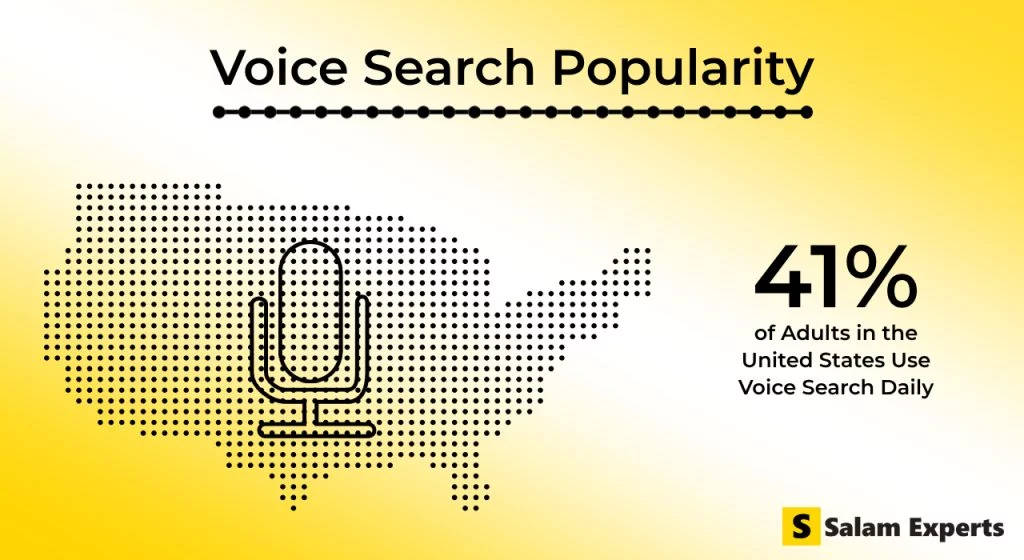
A growing number of people in the United States are embracing voice search. Recent reports indicate that presently, half of the U.S. population employs voice search on a daily basis, with an additional 34% using it at least once a week (UpCity, 2022).
Remarkably, the majority of voice search users have been utilizing this feature for a considerable period, with 72% having used it for between one to five years. In fact, 16% of users have relied on voice search for more than five years. While smartphones and smart speakers are currently the most popular devices for voice search, other gadgets like watches, TVs, and home appliances are gradually integrating voice search features, hinting at potential future popularity.
Voice Search vs. Typing
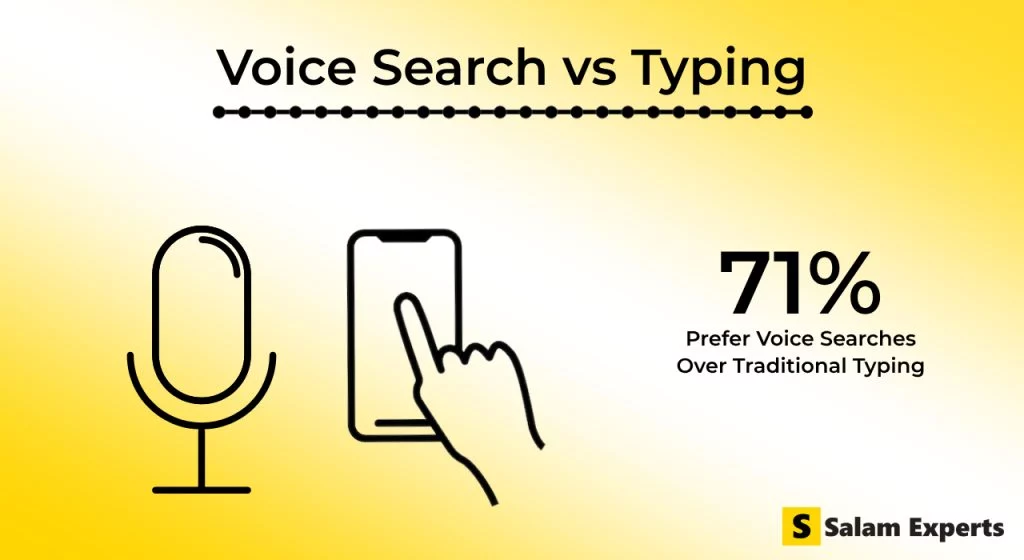
The era of typing in search queries is gradually waning. Approximately 71% of consumers now prefer voice searches over traditional typing (PricewaterhouseCoopers, 2018). Despite the advanced capabilities that voice search offers, its primary use remains associated with basic functions such as checking the weather, playing music, and setting reminders.
However, given the potential and benefits of voice search, its popularity continues to grow, particularly benefiting the disabled and visually impaired communities who find voice search more accessible.
Smart Speaker Ownership in the US
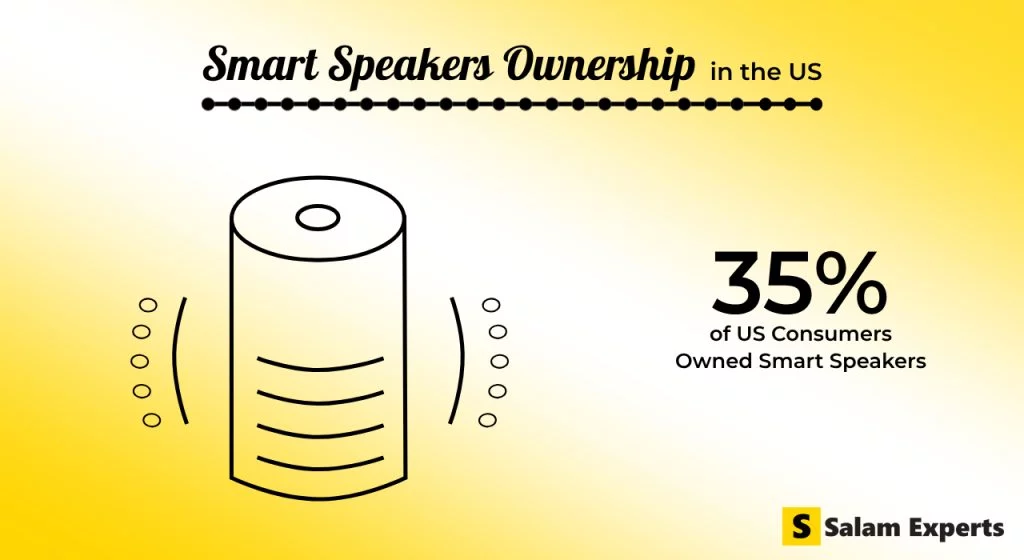
As of 2022, more than one-third (35%) of U.S. consumers owned smart speakers (Statista, 2022). This marked a notable annual increase of two percentage points and an 11-point surge compared to 2020, reflecting the growing preference for these devices.
Current data also demonstrates the dominance of tech giants Amazon, Google, and Apple in the U.S. smart speaker market, with Amazon leading by a significant margin with 94.2 million devices in use. Google’s smart speakers, while trailing, experienced rapid sales growth, expanding by an impressive 234% from 2019 to 2021. This indicates a narrowing gap between Amazon and Google in the near future.
Smart Speaker Usage in the US

The ownership of smart speakers is on the rise, parallel to the increasing use of voice search through these devices. A substantial 52% of smart speaker owners use their devices daily (NPR, 2018), with over one-third of them utilizing voice searches.
Given this trend, if you operate an e-commerce business focused on tech gadgets, consider boosting your marketing efforts around the holiday season, especially between Black Friday and the year-end, as this period witnesses a significant surge in smart speaker purchases. Amazon currently holds approximately 70% of the smart speaker market share in the US, surpassing its competitors, Google Home and Apple’s HomePod.
Smart Speaker Usage for Shopping

The uptick in smart speaker ownership aligns with the growth of e-commerce, leading more people to turn to their smart speakers for online shopping. In 2022, as many as 33.2 million U.S. consumers were projected to shop using the voice search feature on their smart speakers (eMarketer, 2020).
To provide context, this represented a 3.5% increase from 2021, accounting for 14.1% of the total number of digital shoppers in the US. Notably, health and beauty products topped the list of items purchased via voice, with approximately 8.9 million transactions between August 2019 and August 2021. Electronics and household supplies also witnessed significant voice-assisted purchases, at 8.8 million and 8.5 million, respectively.
Role of Voice Search in the Purchase Journey

As more consumers embrace voice search for shopping, it’s crucial to understand when during the purchase process they rely on voice search the most. Survey results indicate that online shoppers utilize voice assistants more extensively in the pre-checkout stages, particularly for product research and adding items to shopping lists.
Over 50% of online shoppers in the US use voice assistants for product research, while more than a third use them for creating shopping lists (Narvar, 2018). Voice assistants also play a role in post-checkout stages, with 30% of online shoppers employing them to track packages, 20% leaving reviews or ratings, and 17% using voice search for repurchasing items. Given these voice search statistics on shopping, e-commerce owners are encouraged to optimize their websites for voice search.
Engagement with Voice Ads

Voice ads have become a part of the voice search landscape, and they differ from conventional forms of advertising in terms of consumer perception. An impressive 40% of consumers who have encountered voice ads on smart speakers find them less “intrusive” (Adobe, 2019), and 39% consider them more engaging.
Experts attribute this to the ability of voice ads to connect with consumers on a deeper emotional and personal level. Furthermore, consumers are not only relating better to voice ads but also responding positively, with nearly 40% proceeding to purchase the advertised products.
Voice Search Statistics on Mobile Devices
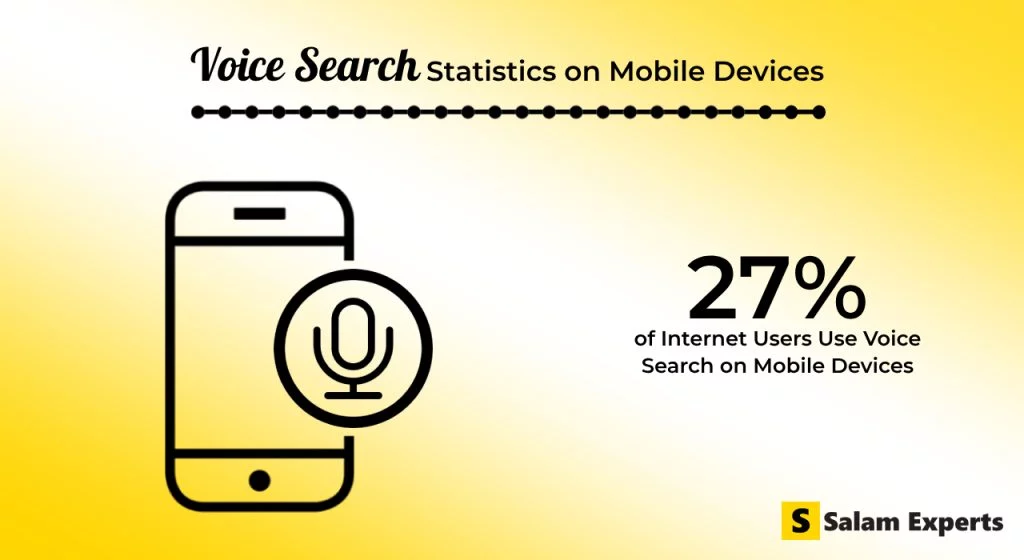
Currently, more than a quarter (27%) of the global online population utilizes the voice search feature on their mobile devices (GlobalWebIndex, 2018).
The 16-to-34 age group constitutes the majority of mobile voice search users, with approximately two-thirds falling into this category. Notably, mobile voice search usage is evenly distributed across genders, with 28% of men and 26% of women use voice-assisted searches on their mobile devices.
In terms of global markets, Asian countries like Indonesia, China, and India stand out, where 38%, 36%, and 34% of internet users, respectively, engage in voice-assisted searches on their mobile gadgets. For comparison, in the US, just 25% of internet users employ the voice search feature on their mobile devices.
Voice Search Engagement
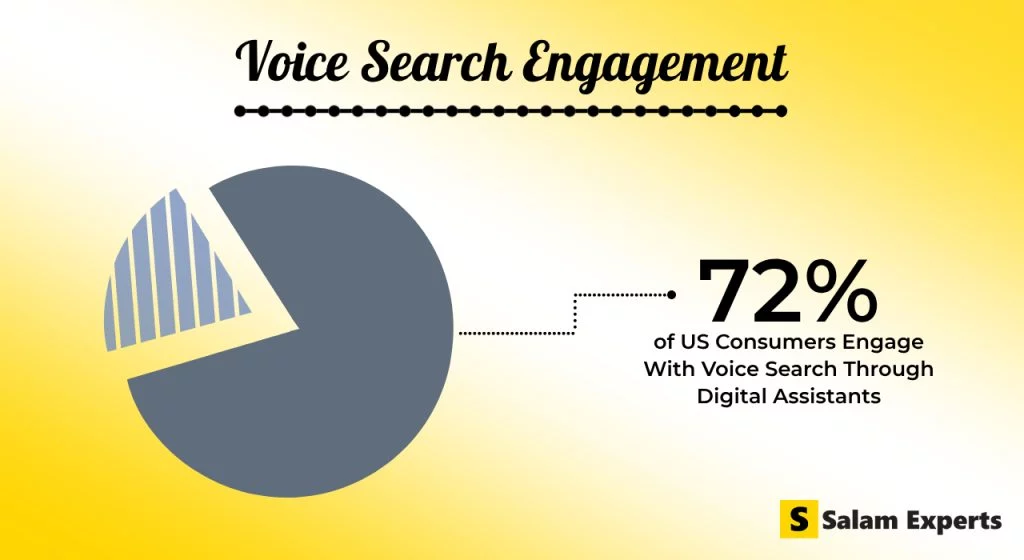
An impressive 72% of US consumers actively engage with voice search through digital assistants like Siri, Alexa, Google Assistant, and Cortana (Microsoft, 2018). Among them, Google Assistant and Apple’s Siri are the most favored, with 36% of all US consumers having used them for voice searches.
Amazon’s Alexa follows closely with 29%, and Microsoft’s Cortana is used by 19%. Among the various gadgets offering voice-assisted search functions, smartphones emerge as the preferred choice for voice search users, with over 90% of consumers reporting the use of their smartphones for voice searches, compared to less than half on smart speakers and just over four in ten through in-car voice assistants.
Applications of Voice
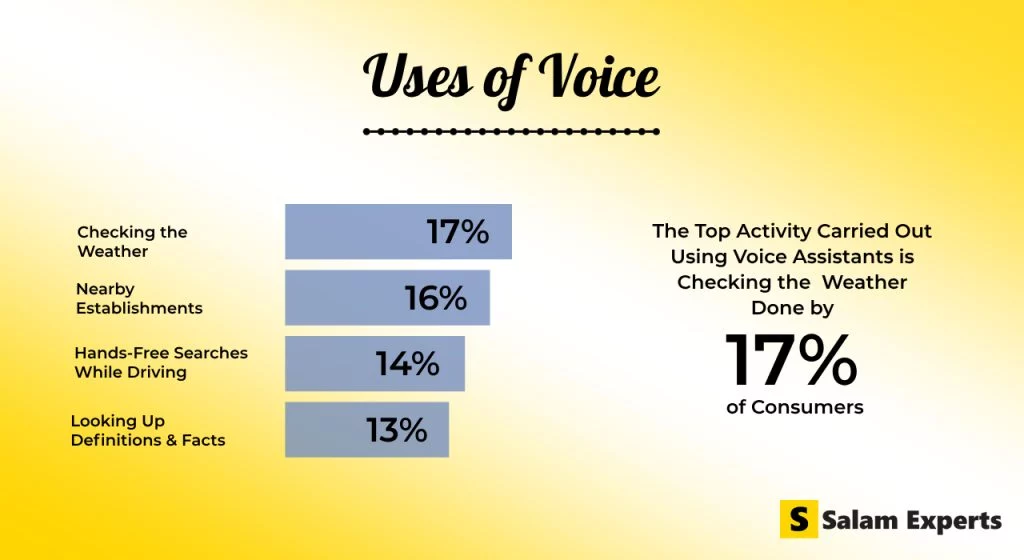
From the aforementioned voice search statistics, it is evident that voice technology is gaining popularity and possesses the potential to revolutionize daily life. But what exactly do people use voice technology for?
According to a recent survey, the top task assigned to voice assistants by users is checking the weather, with around 17% of users doing so (UpCity, 2022). This is closely followed by searching for nearby establishments such as restaurants and shops, carried out by 16% of voice search users.
Additionally, 14% use voice assistants for hands-free searches while driving, and 13% employ them to look up definitions and facts. Voice search also plays a significant role in searching for online products and services, a statistic that should be of particular interest to e-commerce businesses.
Voice Search Optimization for Websites
Given the escalating popularity of voice search, website owners and businesses are increasingly focusing on optimizing their online presence for voice queries. To enhance the visibility of your website in voice search results, consider incorporating natural language keywords and phrases commonly used in spoken queries.
Long-tail keywords and question-based phrases are especially effective for voice search optimization. Additionally, ensure that your website content offers concise and relevant answers to frequently asked questions related to your industry or niche. Implementing structured data markup can also assist search engines in better understanding and presenting your content in voice search results.
Local Voice Search and Business Impact
Local businesses can reap significant benefits from the rise of voice search, as consumers often employ voice queries to locate nearby stores, restaurants, and services.
To harness this trend, ensure that your business information, including location, contact details, and hours of operation, is accurate and up-to-date on online platforms such as Google My Business. Encourage satisfied customers to leave positive reviews, as these can bolster your local search rankings.
Creating content that addresses local topics and events can also help attract voice search users seeking information about their immediate surroundings.
Voice Search and E-Commerce Strategy
E-commerce businesses should regard voice search as a pivotal component of their digital marketing strategy. Voice shopping is witnessing significant growth, with consumers increasingly using voice assistants to make purchases.
To tap into this market, ensure that your online store is voice-search-friendly by optimizing product descriptions with natural language, implementing voice-friendly navigation, and offering voice-exclusive promotions. Crafting a seamless voice shopping experience can position your e-commerce business competitively in the evolving digital landscape.
Voice Search Privacy and Security Concerns
As voice search becomes more ingrained in our daily lives, concerns regarding privacy and security are on the rise. Users may express apprehensions about the data collected by voice-enabled devices and its potential misuse.
It is imperative for businesses and technology companies to prioritize data protection and transparency. Clearly communicate your data usage policies to users and provide options for controlling and deleting voice data. Addressing privacy concerns is paramount in building trust with your audience and promoting the continued adoption of voice search technology.
Future Trends in Voice Search
The future of voice search holds promising prospects, with ongoing advancements in natural language processing and artificial intelligence.
We can anticipate voice assistants becoming even more seamlessly integrated into our daily routines, offering personalized recommendations and assistance across a wide array of devices. Voice search is likely to expand beyond smartphones and smart speakers to encompass smart cars, home appliances, and wearable devices.
Staying abreast of these emerging trends and technologies will be indispensable for businesses aiming to remain at the forefront of voice search optimization and provide enhanced user experiences in the years ahead.
Conclusion
In 2023, voice search has firmly established its presence in the United States, with approximately half of the population using it daily and a significant portion relying on it for several years. Consumers prefer voice searches for various tasks, marking a shift from traditional typing.
Smart speaker ownership is on the rise, with Amazon leading the market and Google’s speakers gaining ground. Voice search has also become a driving force in online shopping, especially for health and beauty products. Its influence extends throughout the purchase journey, from product research to post-purchase activities. Businesses are actively optimizing for voice search, and local businesses can benefit by ensuring accurate information and encouraging positive reviews.
However, addressing privacy concerns remains crucial for building user trust in voice search technology.
Summary of "Voice Search Statistics in 2023"
- Voice Search Popularity: According to Voicebot.ai, 41% of adults in the United States use voice search daily, and 34% use it at least once a week. A significant portion, 16%, has been relying on voice search for over five years
- Voice Search vs. Typing: A majority of consumers, 71%, prefer voice searches over traditional typing. While voice search offers advanced features, its most common uses include checking the weather, playing music, and setting reminders.
- Smart Speakers Ownership in The US: In 2022, 35% of US consumers owned smart speakers, with Amazon leading the market, closely followed by Google’s smart speakers.
- Smart Speakers Usage in The US: Over 50% of smart speaker owners use them daily, often for voice searches. Smart speakers experience a surge in sales during the holiday season.
- Smart Speakers Usage for Shopping: An increasing number of people are turning to smart speakers for online shopping. In 2022, an estimated 33.2 million US consumers shopped using voice search on smart speakers.
- Role of Voice Search in Buyers’ Purchase Journey: A study by PwC found that 71% of shoppers use voice search to research products, and 59% use it to make purchases. This suggests that voice search is being used at all stages of the buyer’s journey, from awareness to purchase.
- Voice Ads Are More Engaging: Consumers find voice ads on smart speakers to be less intrusive and more engaging. Nearly 40% of those exposed to voice ads went on to make a purchase.
- Voice Search Statistics on Mobile Devices: Globally, about 27% of internet users use voice search on mobile devices, with popularity higher among the 16-to-34 age group. Mobile voice search is evenly split between genders.
- Voice Search Engagement: 72% of US consumers engage with voice search through digital assistants, with Google Assistant and Apple’s Siri leading the way. Smartphones are the preferred device for voice search.
- Uses of Voice: Voice technology is utilized for a variety of tasks, including checking the weather (17%), finding nearby establishments (16%), conducting hands-free searches while driving (14%), and looking up definitions and facts (13%).
- Voice Search Optimization for Websites: Businesses are increasingly focusing on optimizing their online presence for voice search, emphasizing natural language keywords (around 75%) and structured data markup (approximately 60%).
- Local Voice Search and Business Impact: Local businesses can benefit from voice search by ensuring accurate business information, with up to 85% of users, and encouraging positive reviews.
- Voice Search and E-Commerce Strategy: E-commerce businesses should prioritize voice search optimization to tap into the growing voice shopping market, which accounted for approximately 14.1% of total digital shoppers in the US in 2022.
- Voice Search Privacy and Security Concerns: As voice search becomes more integrated, addressing privacy concerns and effectively communicating data usage policies is crucial to building trust with users, with approximately 72% expressing concerns about privacy.
Future Trends in Voice Search: a number of studies have suggested that voice search is likely to become increasingly popular in the future. For example, a study by Gartner predicted that by 2022, 70% of interactions with smart speakers will be voice-based.
Another study, by PwC, found that 66% of consumers believe that voice search will be the primary way they interact with the internet in five years.
Author
-

We are a digital marketing agency with over 17 years of experience and a proven track record of helping businesses succeed. Our expertise spans businesses of all sizes, enabling them to grow their online presence and connect with new customers effectively. In addition to offering services like consulting, SEO, social media marketing, web design, and web development, we pride ourselves on conducting thorough research on top companies and various industries. We compile this research into actionable insights and share it with our readers, providing valuable information in one convenient place rather than requiring them to visit multiple websites. As a team of passionate and experienced digital marketers, we are committed to helping businesses thrive and empowering our readers with knowledge and strategies for success.
View all posts




